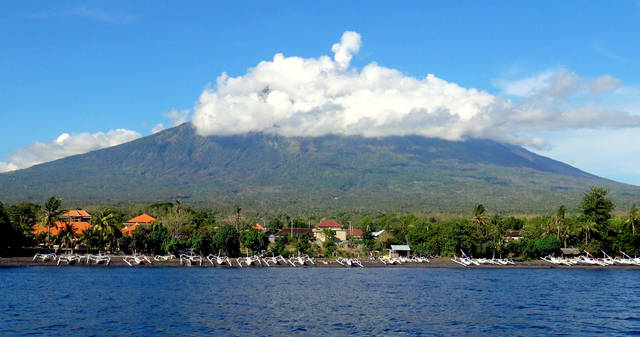LIHUE — Kauai researcher Terry Lilley is still sitting in Wakatobi after Mount Agung’s Tuesday eruption wreaked havoc on transportation in Indonesia.
The island chain is a few hundred miles northeast of Bali in what is known as “The Coral Triangle,” and while Lilley spent the past 10 days studying the underwater life in the area, he and his team are trying to get home.
“We are trying to go as far north of Bali as possible by plane or boat,” Lilley said. “So far we are extremely lucky to still have food and shelter, but we will see what the next few days brings.”
Lilley and a team of professional divers, movie producers and photographers landed in Bali and made themselves at home at Scuba Seraya dive resort three days before the Nov. 28 explosion. It was the first time the volcano had erupted in more than 50 years, and it forced airport closures.
The resort is located at the base of Mount Agung, and was evacuated in November when it was predicted the volcano would erupt. After activity settled, people returned to the resort area — just in time for the actual eruption.
“We were at the dive resort for a week and watched the volcano smoke every day while we were diving,” Lilley said. “I wanted to dive the shipwreck from World War II called Liberty because there is a lot of history on the coral growth there over the last 50 years.”
Minor earthquakes were a part of life during that time, but the team was more fascinated with what was going on under the sea. They took temperatures on 36 different dives — those readings came back ranging from 72 degrees to 86 degrees — and looked for bleaching events and disease.
“The very good part of the trip is that I was successful at documenting that the coral reefs in Indonesia are not suffering from disease and coral bleaching,” Lilley said.
Saturday, three days before the Nov. 28 eruption, Lilley and his team left for Wakatobi, and were on the island chain when the volcano blew.
“I felt so bad for all the dive resort workers and the people in the town because they are now out of a job and do not have many safe places to stay,” Lilley said. “We are also very lucky we did not get stuck at the Bali airport with 60,000 tourists trying to leave!”
The team’s flights from Bali to Manila and then back to Hawaii were canceled, and they were stranded on the chain, half of which is a marine sanctuary with an economy based on selling local catch to divers.
Workers and residents of the area make less than $100 a month, and rely on the dive resort for income, and are concerned as new divers can’t get to Wakatobi while Lilley and the team are trying to leave.
“If the dive resort does not have any clients, they won’t have much business,” Lilley said. “Having the dive resort not operating is very hard on them.”
Still, on Wednesday afternoon Lilley and the team were running out of supplies and are trying to find a charter flight or boat to take them to Suliwesi, Indonesia, and then out to Manila.
While in Bali and Wakatobi, the team dove on eight different small islands and coral atolls and documented coral reef health, as well as interviewed fishermen, divers and scientists about the health of their reefs over the past decade.
“All the coral reefs we dove in in Bali and Wakatobi were in pristine shape and massive amounts of healthy coral,” Lilley said. “The marine life was just stunning, and I shot many hours of underwater video day and night.”









